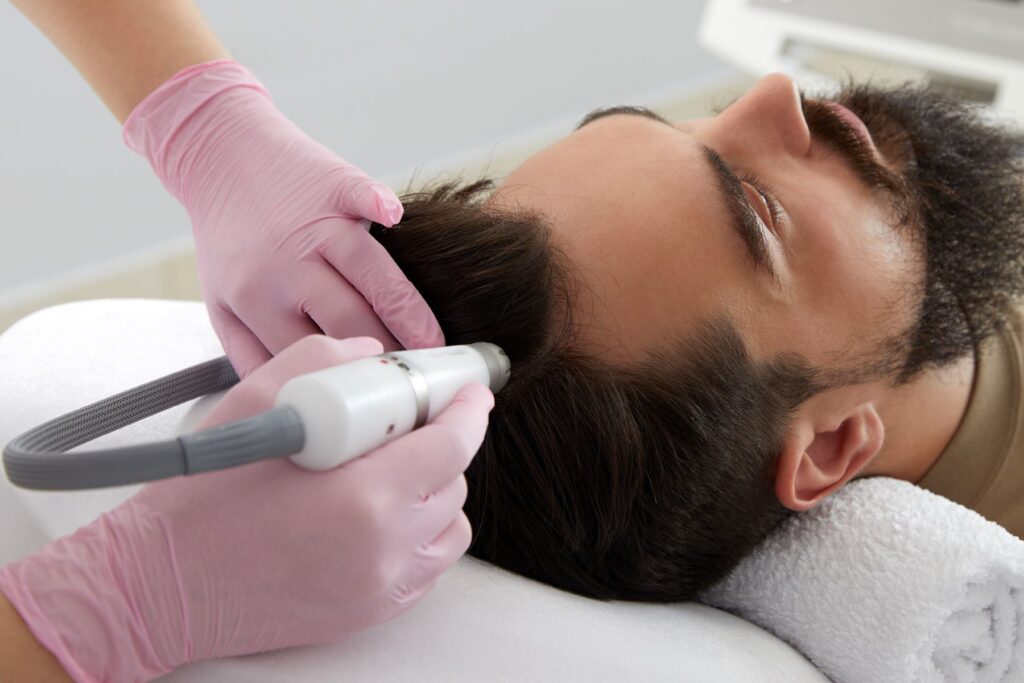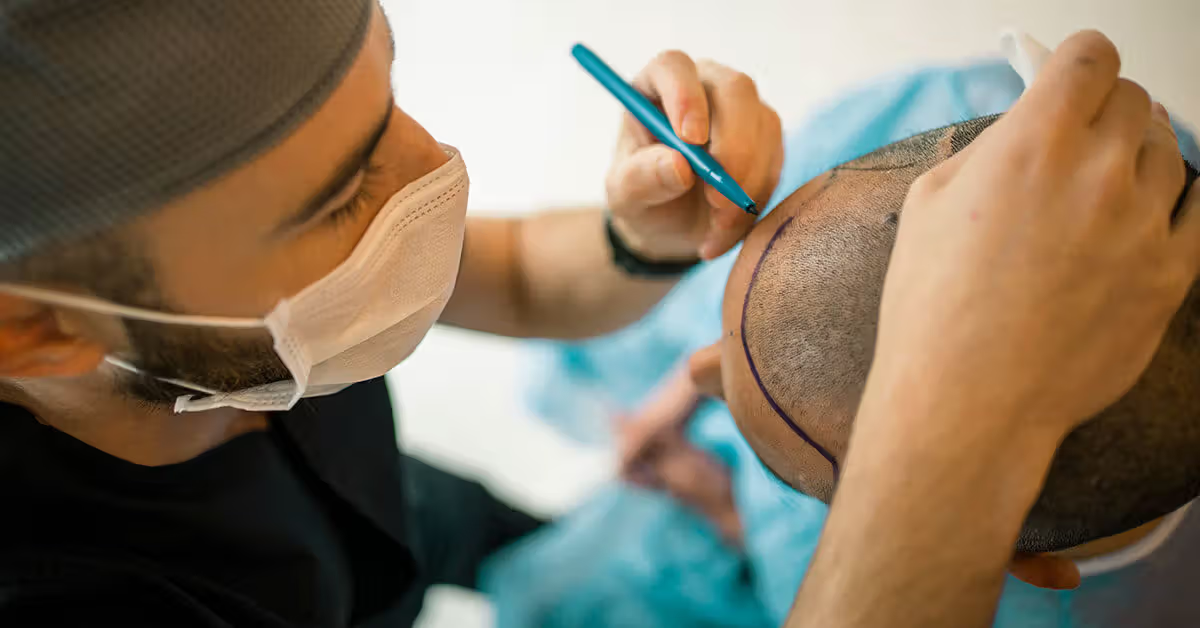
Hair loss can affect people of all ages and backgrounds, leading to a loss of confidence and self-esteem. While hair transplants are a popular surgical solution for hair restoration, not everyone is comfortable with surgery or looking for a permanent procedure. Fortunately, there are several non-surgical alternatives to hair transplants that offer effective results with minimal downtime and risk. In this article, we will explore the various non-surgical methods to restore hair and discuss their benefits, limitations, and how they work.
What is Hair Loss in Hair Transplant
Hair loss, also known as alopecia, occurs when hair falls out faster than it can grow back. This condition affects both men and women, with the most common cause being genetic hair loss (androgenic alopecia). Other causes include stress, hormonal imbalances, poor diet, medical conditions, and medications.
While hair loss can be distressing, it is important to know that there are many options available to help reverse or slow down the process. If you’re not ready for a surgical procedure like a hair transplant, you can explore non-surgical alternatives.
Non-Surgical Alternatives to Hair Transplants
There are several non-surgical alternatives to hair transplants that can help you restore your hair without going under the knife. These methods include:
- Platelet-Rich Plasma (PRP) Therapy
- Low-Level Laser Therapy (LLLT)
- Medications (Finasteride and Minoxidil)
- Hair Pieces and Wigs
- Scalp Micropigmentation (SMP)
- Hair Fibers
- Hair Growth Shampoos and Topical Products
Platelet-Rich Plasma (PRP) Therapy In Hair Transplant
Platelet-Rich Plasma (PRP) therapy is a popular and effective non-surgical treatment for hair restoration. It involves drawing a small amount of blood from the patient, processing it to concentrate the platelets, and injecting it into the scalp. Platelets contain growth factors that promote healing and cell regeneration, which can help stimulate hair follicles and improve hair growth non -surgical.
How Does PRP Therapy Work?
- Blood Draw: A small sample of blood is drawn from the patient’s arm.
- Platelet Concentration: The blood is spun in a centrifuge to separate the platelets from other components.
- Scalp Injection: The concentrated PRP is then injected into the areas of the scalp where hair loss is most prominent.
PRP therapy works by rejuvenating and stimulating the hair follicles, leading to thicker, stronger hair over time. It is a safe procedure with minimal downtime, and the results can be seen after a few sessions.
Benefits of PRP Therapy
- Non-invasive: No surgery or cutting involved.
- Natural Results: Uses the body’s own platelets for hair restoration.
- Quick Recovery: Minimal downtime, with most patients returning to their regular activities immediately.
- Effective for Both Men and Women: Works for individuals with various degrees of hair loss.
Limitations of PRP Therapy
- Multiple Sessions Required: To achieve noticeable results, multiple PRP sessions are necessary, typically spaced a few weeks apart.
- Temporary Results: Results may require maintenance treatments every few months.
Low-Level Laser Therapy (LLLT) In Hair Transplant
Low-Level Laser Therapy (LLLT) is a treatment used to help hair grow after a hair transplant. It works by using special lasers that shine light on the scalp. This light helps improve blood flow to the hair follicles, making them healthier and stronger. LLLT also helps reduce hair loss and can make new hair grow faster. It is a safe and painless treatment that can be used along with a hair transplant to improve results. People who use LLLT after their transplant often see thicker and fuller hair as it helps the scalp heal and grow new hair.
How Does LLLT Work?
- Laser Devices: LLLT can be performed using specialized devices such as helmets, caps, or combs that emit low-level lasers.
- Stimulation of Hair Follicles: The laser energy penetrates the scalp to stimulate hair follicles, leading to better circulation and hair growth.
- Consistency is Key: For best results, LLLT should be used consistently, typically for about 15 to 30 minutes a few times a week.
Benefits of LLLT
- Non-invasive: No surgery or injections are needed.
- Convenient: Can be done at home with devices like laser caps or combs.
- Pain-free: The procedure is gentle and does not cause any discomfort.
- Effective for Early Hair Loss: Works best in the early stages of hair thinning or hair loss.
Limitations of LLLT
- Requires Regular Use: Results are not immediate and require ongoing treatment.
- Mild Results: It may not be as effective for advanced hair loss.
Medications (Finasteride and Minoxidil) In Hair Transplant
Medications like Finasteride and Minoxidil are often used after a hair transplant to help make the hair grow better. Finasteride is a pill that helps stop hair loss by blocking a hormone that can cause hair to fall out. Minoxidil is a liquid that you put on your scalp, and it helps hair grow by improving blood flow to the hair follicles. Both of these medications can make the hair thicker and healthier, helping the transplanted hair grow faster and stronger. When used together with a hair transplant, they can give better and longer-lasting results.
How Do Finasteride and Minoxidil Work?
- Finasteride (Propecia): This oral medication blocks the hormone DHT (dihydrotestosterone), which is responsible for hair follicle shrinkage in men. By reducing DHT, finasteride helps prevent further hair loss and may stimulate new hair growth.
- Minoxidil (Rogaine): Available in topical form (foam or liquid), minoxidil increases blood flow to the hair follicles, promoting hair growth. It works for both men and women and is applied directly to the scalp.
Benefits of Finasteride and Minoxidil
- FDA-Approved: Both medications are scientifically proven to help slow hair loss and promote regrowth.
- Non-invasive: No surgery or injections are required.
- Easy to Use: Both medications can be applied at home, with minimal effort.
Limitations of Finasteride and Minoxidil
- Side Effects: Finasteride may cause side effects like decreased libido, erectile dysfunction, or mood changes in some individuals. Minoxidil may cause scalp irritation in some users.
- Continuous Use: Results from both medications require long-term use. Discontinuing the treatment may cause hair loss to resume.
Hair Pieces and Wigs In Hair Transplant
Hair pieces and wigs can be helpful for people who have hair loss after a transplant. While a hair transplant helps grow new hair, it can take time for results to show. In the meantime, hair pieces or wigs can be worn to cover the bald spots. These are like fake hair that looks real and can be styled just like natural hair. Some people choose to wear them while waiting for their transplant to work, or if they want extra fullness. Hair pieces and wigs help people feel more confident as they wait for their new hair to grow.
How Do Hair Pieces and Wigs Work?
- Customization: Wigs and hairpieces are designed to match the individual’s natural hair color and texture.
- Non-invasive Solution: They provide a cosmetic solution for hair loss without the need for surgery or medications.
- Convenient: They can be worn every day or as needed.
Benefits of Hair Pieces and Wigs
- Immediate Results: Provides instant coverage for hair loss.
- Variety of Options: Available in various styles, lengths, and colors.
- Non-invasive: No surgery, injections, or medications are involved.
Limitations of Hair Pieces and Wigs
- Temporary Solution: Wigs and hairpieces need to be replaced periodically.
- Maintenance: Regular cleaning and care are required to maintain their appearance.
Scalp Micropigmentation (SMP)
Scalp Micropigmentation (SMP) is a treatment that helps make your scalp look like it has more hair. It’s like getting tiny tattoos on your head, which look like little hair follicles. These tiny dots can cover bald spots or make thin hair look fuller. SMP can be a good option for people who don’t want a hair transplant or need something while they wait for their hair to grow non-surgical . The treatment is safe, doesn’t take long, and can help people feel better about their appearance by giving the look of a fuller, thicker head of hair.
How Does SMP Work?
- Tattooing: A trained technician uses a specialized needle to deposit pigment onto the scalp.
- Creating the Illusion of Hair: The dots are strategically placed to create the illusion of a shaved head or fuller hair.
Benefits of SMP
- Instant Results: Results are visible immediately after the procedure.
- Non-invasive: No surgery or cutting required.
- Customizable: The design can be personalized to suit the individual’s preferences and natural hairline.
Limitations of SMP
- Temporary: The pigment may fade over time and require touch-ups.
- Not for Hair Growth: SMP only creates the appearance of hair but does not promote real hair growth.
Hair Fibers In Hair Transplant
Hair fibers are tiny, colored particles that can be sprinkled on the scalp to make hair look thicker. They are often used after a hair transplant to cover any thinning spots while waiting for new hair to grow. The fibers stick to the existing hair, making it look fuller and more natural. Hair fibers come in different colors to match your hair, and they are easy to apply. They are a quick and temporary solution, so people can feel more confident while their transplanted hair starts growing. It’s a simple way to improve the appearance of hair while it heals.
How Do Hair Fibers Work?
- Application: The fibers are sprinkled onto the scalp or directly on thinning areas.
- Bonding with Hair: The fibers adhere to existing hair, creating a fuller, thicker appearance.
Benefits of Hair Fibers
- Quick and Easy: Instant results with minimal effort.
- Affordable: Hair fibers are relatively inexpensive compared to other alternatives.
- Natural Look: When applied correctly, they can provide a natural-looking result.
Limitations of Hair Fibers
- Temporary: Hair fibers must be reapplied regularly and washed out at the end of the day.
- Not for Severe Hair Loss: Best suited for individuals with mild to moderate hair thinning.
Hair Growth Shampoos and Topical Products In Hair Transplant
Hair growth shampoos and topical products are special treatments used after a hair transplant to help new hair grow faster and stronger. These products usually have ingredients that improve blood flow to the scalp and make hair follicles healthier. Some shampoos are gentle and help clean the scalp without causing irritation, while topical products like creams or sprays can be directly applied to the scalp. When used regularly, these products can make transplanted hair grow better and faster. They help nourish the scalp, and many people use them to improve the results of their hair transplant.
How Do Hair Growth Shampoos Work?
- Nourishment: Hair growth shampoos and topical treatments provide nutrients to the scalp and hair follicles.
- Stimulation: Some products use caffeine or other ingredients to stimulate blood flow to the scalp.
Benefits of Hair Growth Shampoos and Topical Products
- Easy to Use: Incorporating them into your daily routine is simple.
- Affordable: These products are often less expensive than other hair restoration methods.
Limitations of Hair Growth Shampoos
- Limited Results: While they can improve the health of your hair and scalp, they may not be as effective for significant hair loss.
- Long-Term Use Required: Continued use is necessary to maintain the benefits.
Conclusion
Hair loss can be a challenging experience, but there are many non-surgical alternatives to hair transplants that can help restore hair and boost confidence. From PRP therapy and laser treatments to hair fibers and wigs, there are options available to suit various preferences and budgets. Before choosing a solution, it’s important to consult with a professional to determine which treatment is best for your specific needs. With the right approach, you can achieve fuller, healthier hair without the need for surgery.

